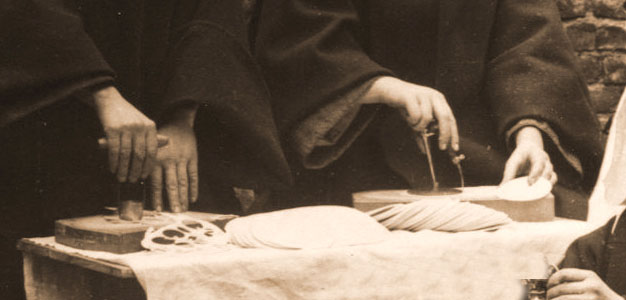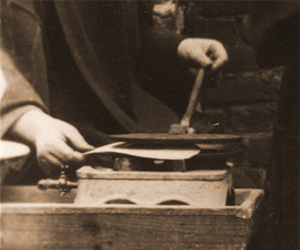
The sisters made altar bread: this unleavened bread, used during mass to become the host. It's a kind of small, very flat waffle. Here is the recipe from the time.
Altar Bread Recipe
The flour, which must be beautiful, new wheat and freshly ground, is thinned little by little with water. The water that must be used must be as lively and as hard as possible such as spring water, fountain or then, rainwater cannot be used. When the flour is well diluted we put about a spoonful of it in the iron which we then put on the fire, the cooking time is one Ave Maria on each side when the fire is well conditioned; for if the fire was not kindled well, more time would be needed; and if it is too hot, you must withdraw your iron more quickly from the edge of the stove and only open it when it is no longer smoking. For the fire coal is preferable to wood, the heat being more equal. The breads are more beautiful. The hot weather is not very favorable for making bread, it is preferably and easier to make in spring and winter.

This mixture is cooked on gas between two iron plates called a host iron, like the one used in the photo on the right by Marie du Sacré-Coeur. These irons have hollow reliefs that are printed on the bread during baking: IHS and IHC monograms or scenes from the Passion of Christ, as can be seen from another iron model of the time on the picture below. We distinguish the relief for large and small hosts. Scraps during cutting of which are sold as clippings.
Manner of polishing new or worked irons

It is sometimes difficult to make bread well with new or wrought irons - when this happens and they have something rough, you have to rub them all over with sandpaper, then take beaten and sifted brick and with a woolen cloth and a little water rub them well – then they are rubbed again with dry tripoli, sometimes you have to come back 3 or 4 hours at various times and even more – after they have been rubbed we heat them up to see how they make the bread (period note)
Cook time
At the Carmel of Lisieux a room under the cloister was specially intended for the production and cooking of hosts: the Office of Altar Bread. There was a water and gas supply for that. The sisters followed one another there, on the day of baking, which sometimes caused them to miss moments when the community was reunited.
The iron is scoured with very fine crushed brick and passed through a sieve, also putting a little olive oil on the iron with a feather. When the flour is good one can sometimes go several days without cleaning the iron; but when it slackens it must be scoured every day and often twice. It is easier to scour it hot than cold. Besides that, when working when the iron turns white, when the bread turns black and cloudy, it must be greased with a little tallow. The first loaves made after the iron has been greased in this way are good only for small calves. (period note).
cutting
Once baked, the altar bread is dried and then cut with a small tool called a roundel, which can be seen in the photo below on the left in the hand of Mother Agnès who cuts small hosts intended for the faithful attending mass . Below on the right, it is the hand of Céline which cuts large hosts intended for the priest celebrating the mass.


Cutting the hosts is a delicate operation which, if done incorrectly, can ruin the whole job by crumbling the bread. As stated in the instruction manual of the time, loaves with lots of designs are much harder to pull off because the more prints the more likely they are to scratch.
Sale at the reception and outside

The altar bread, once cut, is placed in small cardboard boxes for sale. Thérèse takes hosts there to fill the ciborium for the next mass. This is part of her task as sacristan.
The altar bread intended for sale is wrapped up and left on the turn for the people who come to the reception of the monastery. Despite the expense of flour, cooking equipment and gas, the sale of this altar bread brought in nearly 1600 francs a year in the last years of Thérèse's life.


